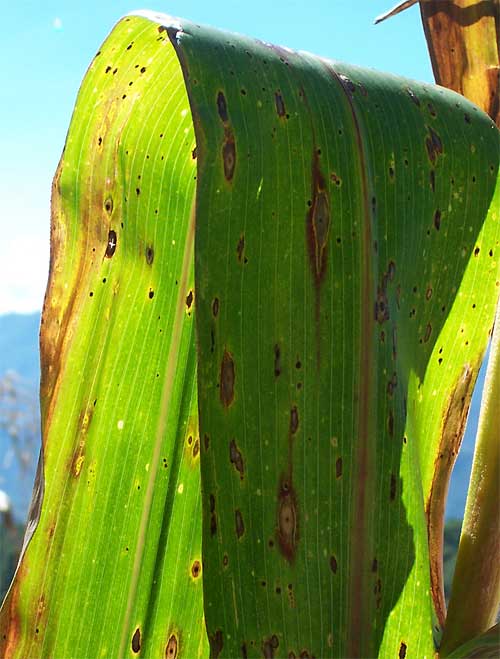
An Excerpt from Jim Conrad's
NATURALIST NEWSLETTER
December
31, 2007
written at Yerba Buena and issued from a ciber in Pueblo Nuevo Solistahuacan, Chiapas, MÉXICO

On Christmas Day, descending from the cloudforest I paused in the upper cornfield to warm in the sunlight and enjoy the view.What caught my eye wasn't in the distance, however, but rather right next to me as I sat on the ground. What I saw was sunlight filtering through a cornstalk's fading leaf-blade, as shown above.
If I were to paint an abstract picture portraying "who I am," I can't imagine producing anything saying it better than that picture. The elemental greens, blues and browns of the Earth and sky, the simple lines, the intense and substantial shadow amidst a rainbow of greens glowing so effervescently that they're more yellow than green, all executed by a somehow sad but very beautiful, dying cornstalk. Who can explain why, at that moment in a Mexican cornfield on Christmas Day, suddenly I was a kid back in rural Kentucky long ago, all of a sudden with roots again, and those roots were lusty and deep.
When one is exiled from his country and culture, whether for politics or ethical principles, at any time of the day or night, from the most unlikely places, nostalgia is likely to stab from nowhere, leaving you stunned and senseless, gawking at the most innocent-seeming of things.
So, as I descended to Yerba Buena I thought about the mighty force of nostalgia, and what I decided about it made me worry. For, soul-bending, inescapable nostalgia is the very engine of tradition, and it turns out that many of our favorite traditions are venomous to Life on Earth. By "venomous" I mean that if most humans on Earth practiced them, the resulting pollution, monoculture land-use, carbon spewed into the air, etc., would wreck the living Earth-ecosystem.
People down here traditionally adorn their Virgin of Guadalupe altars with red and green plants, so nostalgia sends legions of Christmas-spirited folks out ravaging the ecosystem. One of the greatest dangers to Life on Earth well may be that humans prove defenseless in the face of deep-seated nostalgia.
But, to save Life on Earth, right now humanity absolutely must begin dealing with its nostalgic impulses, and abandon its unsustainable traditions.
On an individual basis, one thing this means is that we must learn to judge the effects on the ecosystem of our own behavior. Seeing the Christmas ham on the table, we must learn to see also the large amount of grain the pig had to eat to amass his flesh. We must see all the monocultured land used to grow that pig's grain, and all the pesticides that seeped into rivers to keep the grain bug free. We must see the carbon spewed into the air by diesel-powered engines transporting the grain and we must see how our paying to have that pig killed and dismembered so we could eat his flesh profoundly desensitizes us to other living things, making it even more unlikely that we'll even care whether the rest of the biosphere survives or not.
But, seeing beyond the pig is only part of the answer to how Life on Earth might be saved.
Seeing, then we must react rationally and lovingly, and trade those of our traditions that kill the Earth for traditions more life-confirming, such as welcoming the New Annual Cycle at the Solstice, welcoming spring's returning migrant birds, and welcoming the first Dogwood blossoms.